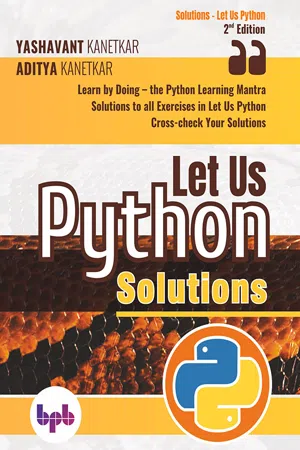
Let Us Python Solutions
Learn by Doing-the Python Learning Mantra
- English
- ePUB (mobile friendly)
- Available on iOS & Android
About This Book
Solutions To All Exercises In Let Us Python, Cross-check Your Solutions.Practice! That Is What Python Programming Is All About. To Be Able To Master Python You Need To Practice Writing A Large Number Of Programs In It. As You Try To Do So, You Would Find That There Are Multiple Ways Of Writing Any Program. So You Need To Find Out Whether You Have Chosen The Best Way To Implement Your Program. That's Where You Would Find This Book Useful.'let Us Python' Contains Exercises At The End Of Each Chapter. Solving These Exercises Would Help You Build Your Python Skills. As You Do So, Many Of You Would Feel The Need For A Trusted Companion Who Will Ratify Your Answers And Programs. 'let Us Python Solutions' Will Be That Trusted Companion. It Will Help You Validate Your Answers And Teach You How To Write Better Python Programs.Key FeaturesStrengthens The Foundations, As Detailed Explanations Of Programming Language Concepts Are Given In A Simple Manner.Lists Down All The Important Points That You Need To Know Related To Various Topics In An Organized Manner.Prepares You For Coding Related Interviews And Theoretical Questions.It Provides An In-depth Explanation Of Complex Topics And Questions.It Focuses On How To Think Logically To Solve A Problem.Follows A Systematic Approach That Will Help You To Prepare For An Interview In A Short Duration Of Time.Exercises Are Exceptionally Useful To Complete The Reader's Understanding Of A Topic.What Will You LearnData Types, Control Flow Instructions, Console & File Input/outputStrings, List & Tuples, List ComprehensionSets & Dictionaries, Functions & LambdasDictionary ComprehensionModules, Classes And Objects, InheritanceOperator Overloading, Exception HandlingIterators & Generators, Decorators, Command-line ParsingWho This Book Is ForStudents, Programmers, Researchers, And Software Developers Who Wish To Learn The Basics Of Python Programming Language.About the AuthorsYashavant Kanetkar: Through his books and Quest Video Courses on C, C++, Java, Python, Data Structures,.NET, IoT, etc. Yashavant Kanetkar has created, molded and groomed lacs of IT careers in the last three decades. Yashavant's books and Quest videos have made a significant contribution in creating top-notch IT manpower in India and abroad. Yashavant's books are globally recognized and millions of students/professionals have benefitted from them. Yashavant's books have been translated into Hindi, Gujarati, Japanese, Korean and Chinese languages. Many of his books are published in India, the USA, Japan, Singapore, Korea and China. Yashavant is a much sought after speaker in the IT field and has conducted seminars/workshops at TedEx, IITs, IIITs, NITs and global software companies. Yashavant has been honored with the prestigious "Distinguished Alumnus Award" by IIT Kanpur for his entrepreneurial, professional and academic excellence. This award was given to the top 50 alumni of IIT Kanpur who have made a significant contribution towards their profession and the betterment of society in the last 50 years. In recognition of his immense contribution to IT education in India, he has been awarded the "Best.NET Technical Contributor" and "Most Valuable Professional" awards by Microsoft for 5 successive years. Yashavant holds a BE from VJTI Mumbai and M.Tech. from IIT Kanpur.Aditya Kanetkar is currently working as a Software Engineer at Microsoft Corp., Seattle. Aditya's current passion is anything remotely connected to Python, Machine Learning, Distributed Systems, Cloud Computing, and C# related technologies. Aditya was formerly at Oracle America Inc. in Redwood City, California. Aditya holds a MS in Computer Science from Georgia Tech, Atlanta and B.Tech in Computer Science from IIT Guwahati.
Frequently asked questions
Information
1
Introduction to Python
| a. Functional programming | 1. GUI element based interaction |
| b. Event-driven programming | 2. Interaction of objects |
| c. Procedural programming | 3. Statements |
| d. Object-oriented programming | 4. Maths-like functions |
2
Python Basics
Table of contents
- Cover Page
- Title Page
- Copyright Page
- Dedication
- About the Authors
- Table of Contents
- 1 Introduction to Python
- 2 Python Basics
- 3 Strings
- 4 Decision Control Instruction
- 5 Repetition Control Instruction
- 6 Console Input/Output
- 7 Lists
- 8 Tuples
- 9 Sets
- 10 Dictionaries
- 11 Comprehensions
- 12 Functions
- 13 Recursion
- 14 Functional Programming
- 15 Modules and Packages
- 16 Namespaces
- 17 Classes and Objects
- 18 Intricacies of Classes and Objects
- 19 Containership and Inheritance
- 20 Iterators and Generators
- 21 Exception Handling
- 22 File Input/Output
- 23 Miscellany
- 24 Multi-threading
- 25 Synchronization